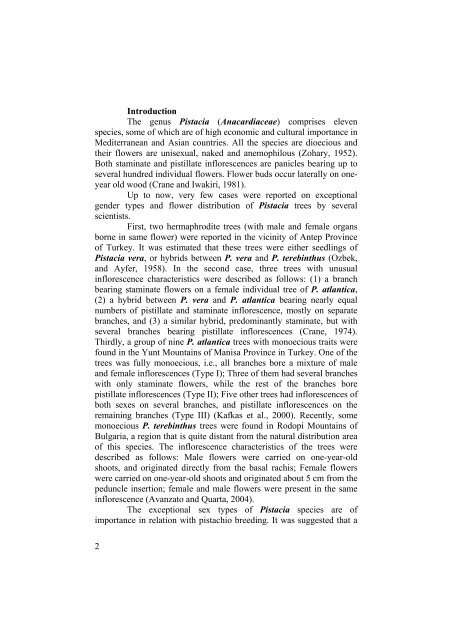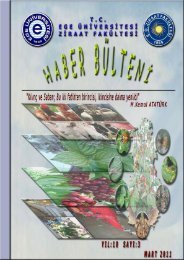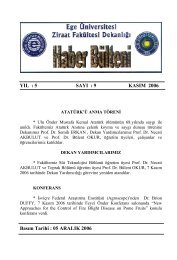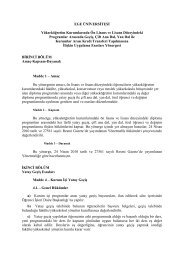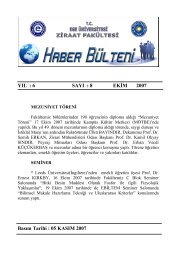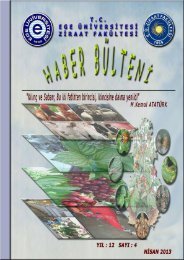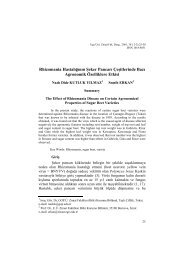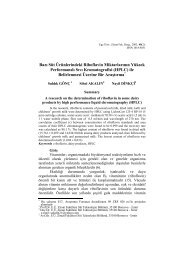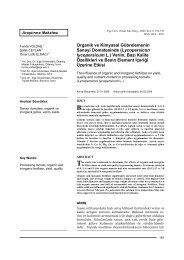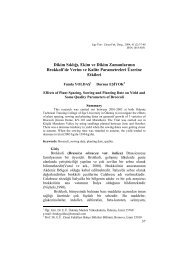Hermaphroditism in Pistacia atlantica Desf. : A New Report from ...
Hermaphroditism in Pistacia atlantica Desf. : A New Report from ...
Hermaphroditism in Pistacia atlantica Desf. : A New Report from ...
You also want an ePaper? Increase the reach of your titles
YUMPU automatically turns print PDFs into web optimized ePapers that Google loves.
Introduction<br />
The genus <strong>Pistacia</strong> (Anacardiaceae) comprises eleven<br />
species, some of which are of high economic and cultural importance <strong>in</strong><br />
Mediterranean and Asian countries. All the species are dioecious and<br />
their flowers are unisexual, naked and anemophilous (Zohary, 1952).<br />
Both stam<strong>in</strong>ate and pistillate <strong>in</strong>florescences are panicles bear<strong>in</strong>g up to<br />
several hundred <strong>in</strong>dividual flowers. Flower buds occur laterally on oneyear<br />
old wood (Crane and Iwakiri, 1981).<br />
Up to now, very few cases were reported on exceptional<br />
gender types and flower distribution of <strong>Pistacia</strong> trees by several<br />
scientists.<br />
First, two hermaphrodite trees (with male and female organs<br />
borne <strong>in</strong> same flower) were reported <strong>in</strong> the vic<strong>in</strong>ity of Antep Prov<strong>in</strong>ce<br />
of Turkey. It was estimated that these trees were either seedl<strong>in</strong>gs of<br />
<strong>Pistacia</strong> vera, or hybrids between P. vera and P. tereb<strong>in</strong>thus (Ozbek,<br />
and Ayfer, 1958). In the second case, three trees with unusual<br />
<strong>in</strong>florescence characteristics were described as follows: (1) a branch<br />
bear<strong>in</strong>g stam<strong>in</strong>ate flowers on a female <strong>in</strong>dividual tree of P. <strong>atlantica</strong>,<br />
(2) a hybrid between P. vera and P. <strong>atlantica</strong> bear<strong>in</strong>g nearly equal<br />
numbers of pistillate and stam<strong>in</strong>ate <strong>in</strong>florescence, mostly on separate<br />
branches, and (3) a similar hybrid, predom<strong>in</strong>antly stam<strong>in</strong>ate, but with<br />
several branches bear<strong>in</strong>g pistillate <strong>in</strong>florescences (Crane, 1974).<br />
Thirdly, a group of n<strong>in</strong>e P. <strong>atlantica</strong> trees with monoecious traits were<br />
found <strong>in</strong> the Yunt Mounta<strong>in</strong>s of Manisa Prov<strong>in</strong>ce <strong>in</strong> Turkey. One of the<br />
trees was fully monoecious, i.e., all branches bore a mixture of male<br />
and female <strong>in</strong>florescences (Type I); Three of them had several branches<br />
with only stam<strong>in</strong>ate flowers, while the rest of the branches bore<br />
pistillate <strong>in</strong>florescences (Type II); Five other trees had <strong>in</strong>florescences of<br />
both sexes on several branches, and pistillate <strong>in</strong>florescences on the<br />
rema<strong>in</strong><strong>in</strong>g branches (Type III) (Kafkas et al., 2000). Recently, some<br />
monoecious P. tereb<strong>in</strong>thus trees were found <strong>in</strong> Rodopi Mounta<strong>in</strong>s of<br />
Bulgaria, a region that is quite distant <strong>from</strong> the natural distribution area<br />
of this species. The <strong>in</strong>florescence characteristics of the trees were<br />
described as follows: Male flowers were carried on one-year-old<br />
shoots, and orig<strong>in</strong>ated directly <strong>from</strong> the basal rachis; Female flowers<br />
were carried on one-year-old shoots and orig<strong>in</strong>ated about 5 cm <strong>from</strong> the<br />
peduncle <strong>in</strong>sertion; female and male flowers were present <strong>in</strong> the same<br />
<strong>in</strong>florescence (Avanzato and Quarta, 2004).<br />
The exceptional sex types of <strong>Pistacia</strong> species are of<br />
importance <strong>in</strong> relation with pistachio breed<strong>in</strong>g. It was suggested that a<br />
2


